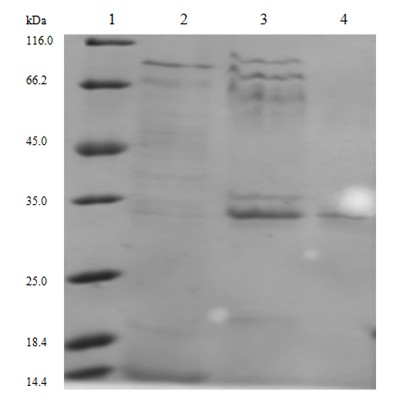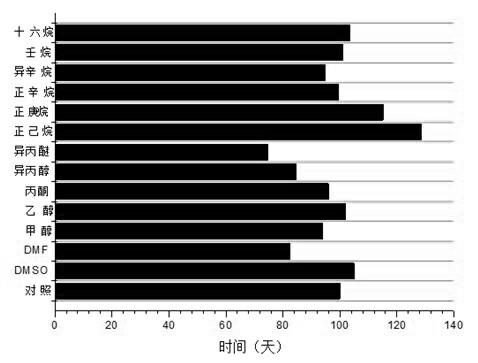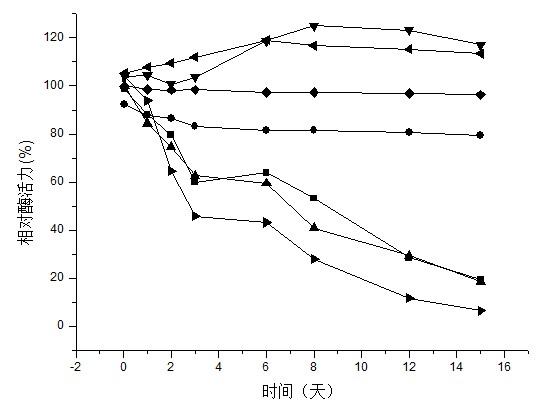High-stability organic solvent-resistant lipase producing strain and lipase as well as gene and application thereof
A technology that is resistant to organic solvents and lipase, applied in applications, genetic engineering, plant genetic improvement and other directions, can solve problems such as enzyme instability, and achieve the effects of easy purification, good temperature stability, and good application prospects.
- Summary
- Abstract
- Description
- Claims
- Application Information
AI Technical Summary
Problems solved by technology
Method used
Image
Examples
Embodiment 1
[0025] This experiment illustrates the screening procedure for natural strains producing organic solvent-resistant lipase.
[0026] The initial screening adopts the following method: use vegetable oil as the only carbon source, and organic solvents such as cyclohexane, toluene, and DMSO at different concentrations as the screening pressure to obtain organic solvent-resistant extremophiles from oily soil and other samples. Tween-80 plate medium was used, and the specific formula was: yeast extract 5 g / L, peptone 10 g / L, NaCl 10 g / L, Tween-80 10 mL / L, CaCl 2 1 g / L, agar 20 g / L. The screened organic solvent-resistant microorganisms were inoculated on Tween-80 plates, and the strains with high lipase production were preliminarily screened according to the ratio of the sedimentation circle to the colony size. Five extremophile strains resistant to organic solvents with high lipase production were screened by this method.
[0027] In order to further detect the solvent tolerance ...
Embodiment 2
[0030] This experiment illustrates the biological properties, identification and enzyme production conditions of organic solvent-resistant lipase-producing bacteria YCJ01.
[0031] Biological properties of the strain YCJ01: the strain is a Gram-negative strain, and the colony is beige, round, with neat edges, smooth and moist; The optimum temperature is 30°C to 35°C. Its physiological and biochemical characteristics are manifested in: no denitrification reaction, gelatin reaction result is positive, oxidase positive, can decompose fat, can use D-ribose, D-arabinose, trehalose, etc., can not use maltose.
[0032] Identification of strain YCJ01: After identification by BIOLOG automatic bacterial identification instrument, the Sim value was 0.576 (24h culture), and the identification results showed that the bacteria belonged to Burkholderia genus; after 16S rDNA sequence analysis, it was shown that the strain was similar to that in the database Burkholderia ambifaria The homol...
Embodiment 3
[0035] This experiment illustrates the purification procedure of organic solvent-resistant lipase YCJ01.
[0036] Will Burkholderia cepacia After YCJ01 was cultured in the enzyme-producing medium for 60 hours, the fermentation broth was centrifuged at 10,000rmp at 4°C for 15 minutes, and the supernatant was taken as the crude enzyme solution; Purified, eluted with 0.05 M Tris-HCl (pH 7.25, NaCl 1 mol / L) buffer stage, collected lipase activity peak, and 0.05 M Tris-HCl (pH 7.25, (NH 4 ) 2 SO 4 0.05 M Tris-HCl (pH 7.25) containing 20% ethanol and 0.05M Tris-HCl (pH 7.25) containing 40% ethanol ) solution to collect lipase activity peaks. Through SDS-PAGE electrophoresis, it was found that the two-step purified organic solvent-resistant lipase (named organic solvent-resistant YCJ01 lipase) had reached electrophoretic purity ( figure 1 ), the apparent molecular weight of the lipase is about 33 kDa. The purification multiple was 12.5 times, the recovery rate was 24.2%, an...
PUM
| Property | Measurement | Unit |
|---|---|---|
| molecular weight | aaaaa | aaaaa |
Abstract
Description
Claims
Application Information
 Login to View More
Login to View More - R&D
- Intellectual Property
- Life Sciences
- Materials
- Tech Scout
- Unparalleled Data Quality
- Higher Quality Content
- 60% Fewer Hallucinations
Browse by: Latest US Patents, China's latest patents, Technical Efficacy Thesaurus, Application Domain, Technology Topic, Popular Technical Reports.
© 2025 PatSnap. All rights reserved.Legal|Privacy policy|Modern Slavery Act Transparency Statement|Sitemap|About US| Contact US: help@patsnap.com



